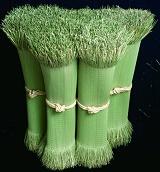Kunisaki Shichitoi Omote
| Numero di registrazione | 22 |
|---|---|
| Nome del prodotto | Kunisaki Shichitoui Omote |
| Classe | Altri prodotti |
| Data di registrazione | 2016/12/07 |
| Area di produzione |
Prefettura di Ooita
Città di Kunisaki e città di Kitsuki |
| Organismo di controllo Consorzio di tutela | Kunisaki Shichitoui Promotion Association 3209 Tomikiyo Akimachi Kunisaki-City, Oita Prefecture, 873-0355, Japan |
Kunisaki Shichitoi Omote is a rug made of shichitoi (plant of the Cyperaceae family originating in Southeast Asia), a plant grown in Kunisaki City or Kizuki City, Oita. Compared to ordinary reed mats, it has a natural texture with more than double the perspiration resistance, and is 5 to 6 times stronger. For these reasons, it has been an indispensable rug used for judo tatami, craftsmen's studios and theater galleries since olden times.
While tatami facings made from ordinary soft rush are woven with two threads per row, Kunisaki Shichitoi Omote, as can be seen from its other name Ao-mushiro (blue reed mats), is woven roughly with one thread per row just like the other reed mats. Kunisaki Shichitoi Omote gradually changes its color from cream to yellow-brown, and unlike ordinary reed facing, it develops a sheen and becomes increasingly refined as it is used longer.
It is thought that cultivation and processing of shichitoi were carried out in Ryukyu (Okinawa Prefecture) and the Satsuma Clan (Kagoshima Prefecture) from even before the Edo period (1600 to 1868). In 1660, it arrived in Oita Prefecture, and then spread rapidly to the area around Beppu Bay.
Shichitoi grows vigorously in subtropical climates, though the epidermis becomes hard. On the other hand, it is weak at low temperatures, and if the ground continues to freeze in winter, the rhizome will be damaged. After planting, it is necessary to keep it in a dry state to avoid disease. The Kunisaki Peninsula is a region with long sunshine hours, relatively low precipitation and a climate where frost ever forms in winter, optimum conditions for cultivating Shichitoi.
During the Edo period, Ao mushiro from Oita was known under the name of Bungo omote, and in later years, production amounted to 3 million mats. After the reconstruction following the Second World War, there was a period when production surpassed 5.5 million mats nationwide, but thereafter the number of producers declined rapidly due to mainly industrialization policies of this region.
Under such circumstances, a tatami company in Oita Prefecture started activities in 2009 to prevent the disappearance of the shichitoi production area, and the following year, the Kunisaki Shichitoi Promotion Association was established with many collaborators. At that time, there were only about 5 producers, mainly elderly people, and the production area was almost extinguished, but thereafter, the number of new farmers increased, and activities to restore production areas are now being developed.


